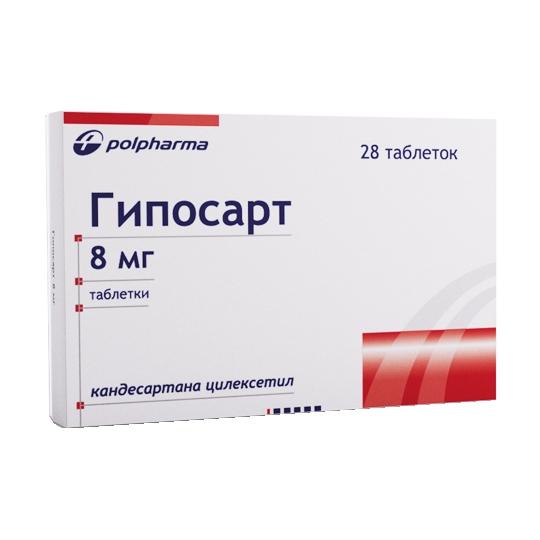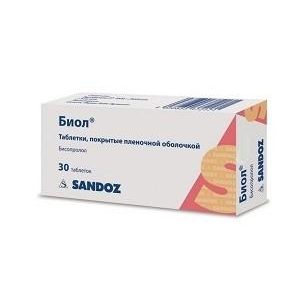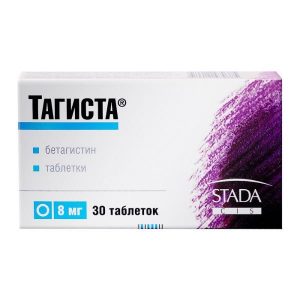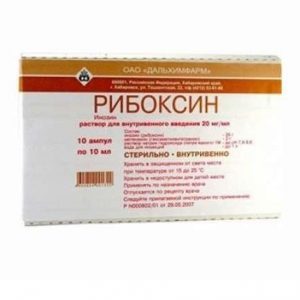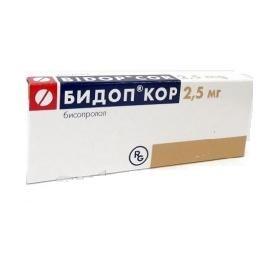Description
Release form
Tablets
Pharmacological action
Angiotensin II receptor antagonist. Angiotensin II – the main enzyme of RAAS, taking part in the pathogenesis of arterial hypertension, heart failure and other cardiovascular diseases.
Candesartan is a selective antagonist of angiotensin II receptors, subtype 1 (AT1 receptors). It does not exhibit agonist properties (does not affect ACE and does not lead to the accumulation of bradykinin or substance P, does not bind to receptors of other hormones, does not affect the state of ion channels involved in the regulation of the cardiovascular system). As a result of the blocking of AT1 receptors of angiotensin II, a compensatory dose-dependent increase in the activity of renin, the concentration of angiotensin I, angiotensin II and a decrease in the concentration of aldosterone in blood plasma occurs.
Arterial hypertension
The intake of candesartan by mouth provides a dose-dependent, a smooth decrease in blood pressure due to a decrease in heart rate without a reflex increase in heart rate. There is no data on the development of severe arterial hypotension after taking the first dose or on the development of withdrawal syndrome after discontinuation of therapy.
The onset of antihypertensive action after taking the first dose of the drug usually develops within 2 hours, the duration of the effect is 24 hours. Against the background of continued therapy with candesartan in a fixed dose, the maximum decrease in blood pressure is usually achieved within 4 weeks and lasts throughout the treatment. The addition of a thiazide diuretic hydrochlorothiazide to candesartan enhances its antihypertensive effect.
The age and gender of the patient do not affect the effectiveness of the drug. Candesartan increases renal blood flow and does not alter or increase glomerular filtration rate, while renal vascular resistance and filtration fraction are reduced.
Candesartan has a less pronounced antihypertensive effect in patients of the Negroid race (a population with predominantly low plasma renin activity).
There is no evidence of the effect of candesartan on the progression of diabetic nephropathy. In patients with arterial hypertension and type 2 diabetes, candesartan does not adversely affect blood glucose concentration and lipid profile.
Heart failure
Candesartan therapy reduces mortality and hospitalization in patients with chronic heart failure (CHF), regardless of age, gender, and concomitant therapy, leading to a decrease in the functional class of CHF according to NYHA classification.
Candesartan is effective in patients taking simultaneously beta-blockers in combination with ACE inhibitors, while its effectiveness is independent of the dose of an ACE inhibitor. In patients with heart failure and decreased systolic function of the left ventricle (left ventricular ejection fraction (LVEF) less than 40%), candesartan reduces OPSS and jamming pressure in the pulmonary capillaries.
Indications
– arterial hypertension
– chronic heart failure and impaired systolic function of the left ventricle (LVEF 40%) as adjunctive therapy for ACE inhibitors or for intolerance to ACE inhibitors.
Contraindications
– hypersensitivity to candesartan or other components of the
preparation – lactose intolerance, lactase deficiency, glucose-galactose malabsorption syndrome
– pregnancy
– breastfeeding period
– children and adolescents under 18 years of age (efficacy and safety have not been established)
– severe liver dysfunction and / or cholestasis
– simultaneous use with patients’ aliskiren and aliskiren containing with diabetes mellitus or impaired renal function (GFR less than 60 ml / min).
Precautions: severe renal impairment (CC less than 30 ml / min), hemodialysis, bilateral renal artery stenosis or stenosis of a single kidney artery, hemodynamically significant stenosis of the aortic and / or mitral valve, hypertrophic obstructive cardiomyopathy (GOKMP), condition after kidney transplantation cerebrovascular disorders of ischemic origin and ischemic heart disease, hyperkalemia in patients with reduced BCC, general anesthesia and surgery (risk of developing arterial hypotension due to RAAS blockade), primary hyperaldosteronism.
Use during pregnancy and lactation
Hyposart is contraindicated in pregnancy, as it has a direct effect on RAAS and can cause fetal development disorders (especially in the second and third trimesters of pregnancy) or have a negative effect on a newborn, up to a fatal outcome, if the drug was used during pregnancy.
known that therapy with angiotensin II receptor antagonists (ARA II) can cause fetal development disorders (impaired renal function, oligohydramnios, delayed ossification of the bones of the skull) and the development of complications in the newborn (renal failure, arterial hypotension, hyperkalemia). When establishing the fact of pregnancy, the Hyposart drug must be canceled as soon as possible.
When planning pregnancy, it is necessary to transfer the patient to adequate alternative therapy.
It is not known whether candesartan is excreted in breast milk, but it is known to pass into the milk of lactating rats.
During treatment with Hypososart, breast-feeding should be discontinued. Newborns whose mothers received Hyposart during pregnancy, should be under close medical supervision because of the likelihood of developing arterial hypotension.
Special instructions
Ethnic features
The antihypertensive effect of candesartan in patients of the Negroid race is less pronounced compared to patients of other races, and therefore, an increase in the dose of the Hyposart drug, as well as combination with other antihypertensive agents, is required.
Impaired renal function
Experience with the use of the drug in patients with severe renal insufficiency or in end-stage renal failure (CC <15 ml / min) is limited. In such patients, a careful selection of the dose of the Hyposart drug is required under the strict control of blood pressure. In patients with heart failure, especially those over 75 years old, and in patients with impaired renal function, renal function should be monitored periodically. During the selection of a dose of Hyposart, it is recommended to control the concentration of creatinine and potassium in the blood serum. Combination therapy with an ACE inhibitor in heart failure When using Hyposart in combination with an ACE inhibitor, the risk of side effects may increase: impaired renal function and hyperkalemia. In these cases, careful monitoring and control of relevant laboratory parameters is necessary. Hemodialysis During hemodialysis, blood pressure may be especially sensitive to blockade of AT1 receptors as a result of a decrease in bcc and activation of RAAS. Therefore, patients on hemodialysis need blood pressure control and an individual dose selection of Hyposart. Renal artery stenosis Drugs that affect RAAS, such as ACE inhibitors, may cause hyperuricemia and hypercreatininemia in patients with bilateral renal artery stenosis or single kidney artery stenosis. A similar effect may develop with the use of ARA II. Kidney transplantation There is no experience with the drug in patients who have recently undergone kidney transplantation. Arterial hypotension Arterial hypotension may develop in patients with heart failure receiving Hyposart. It is also possible the development of arterial hypotension in patients with reduced BCC, for example, receiving diuretics in high doses. At the beginning of therapy, care must be taken and, if necessary, compensated for BCC. General anesthesia / surgery When performing surgery under general anesthesia in patients taking ARA II, arterial hypotension due to RAAS blockade may develop. Very rarely, arterial hypotension can be severe and require iv administration of fluid and / or vasopressors. Aortic and / or mitral valve stenosis, GOKMP Hyposart should be used with caution in patients with hemodynamically significant aortic and / or mitral valve stenosis or with GOKMP. Primary hyperaldosteronism Patients with primary hyperaldosteronism are resistant to antihypertensive drugs that affect RAAS, so the use of Hyposart is not recommended for such patients. Hyperkalemia The simultaneous use of the drug Hyposart and potassium-sparing diuretics, potassium preparations, salt substitutes containing potassium, or other means, capable of increasing the concentration of potassium in serum (for example, heparin), can lead to the development of hyperkalemia in patients with arterial hypertension. Hyperkalemia can also develop in patients with heart failure, taking Hyposart. Against the background of therapy with the Hyposart drug in patients with heart failure, it is recommended to periodically monitor the concentration of potassium in the blood serum, especially with the simultaneous use of ACE inhibitors and potassium-sparing diuretics (spironolactone, eplerenone, triamteren, amiloride). General Patients whose vascular tone and renal function mainly depend on RAAS activity (for example, patients with severe decompensated heart failure or concomitant kidney disease, including unilateral renal artery stenosis), therapy with other drugs that affect RAAS accompanied by the development of arterial hypotension, azotemia, oliguria, and less commonly, acute renal failure. This cannot be ruled out for angiotensin II receptor antagonists. An excessive decrease in blood pressure in patients with coronary heart disease or cerebrovascular diseases of ischemic origin can lead to the development of myocardial infarction or stroke. Double blockade of RAAS when using drugs containing aliskiren Double blockade of RAAS is not recommended by the simultaneous use of candesartan and aliskiren, due to the increased risk of hypotension, hyperkalemia and impaired renal function. Effect on the ability to drive vehicles and control mechanisms Effect of the drug Hyposart on the ability to drive vehicles and work with complex mechanisms has not been studied, but the pharmacodynamic properties of the drug indicate that there is no such effect. Caution must be exercised when driving and engaging in potentially hazardous activities that require an increased concentration of attention and speed of psychomotor reactions due to the risk of dizziness. Composition 1 tab. candesartan cilexetil 8 mg Excipients: lactose monohydrate – 197.9 mg, corn starch – 40 mg, hyprolose (viscosity, water, 25 ° C (5%) 75-150 cps) – 4 mg, , water, 25 ° (5%) 1500-3000 cps) – 4 mg, macrogol 6000 – 5.2 mg, magnesium stearate – 0.8 mg, iron dye red oxide (E172) – 0.1 mg. Dosage and administration The drug is taken orally, 1 time / day, regardless of the meal time. Arterial hypertension The recommended initial and maintenance dose of Hyposart is 8 mg 1 time / day. If necessary, the dose can be increased to 16 mg 1 time / day. The maximum antihypertensive effect is achieved within 4 weeks of therapy. The maximum daily dose is 32 mg 1 time / day. If, against the background of the maximum daily dose, adequate control of blood pressure is not achieved, it is recommended to add a thiazide diuretic to the therapy (for example, hydrochlorothiazide). This can enhance the antihypertensive effect of the drug Hyposart. In patients at risk of developing arterial hypotension (including patients with reduced BCC), therapy is recommended to be started with a dose of 4 mg. In patients with mild and moderate renal impairment (CC 30-80 ml / min / 1.73 m2), including patients on hemodialysis, the initial dose of the drug is 4 mg. The dose should be titrated depending on the therapeutic effect. Clinical experience with the use of the drug in patients with severe renal impairment or end-stage renal failure (CC less than 15 ml / min) is limited. The initial daily dose of the drug in patients with mild and moderate liver disease is 4 mg. Possible dose increase if necessary. There is no clinical experience with the use of the drug in patients with severe hepatic impairment and / or cholestasis. Chronic heart failure The recommended initial dose of Hyposart is 4 mg 1 time / day. An increase to the maximum daily dose of 32 mg 1 time / day or to the maximum tolerated dose is carried out by doubling the dose with an interval of at least 2 weeks. Elderly patients and patients with impaired renal or hepatic function do not need to adjust the initial dose of the drug. Safety and efficacy of Hyposart in children and adolescents under the age of 18 have not been established. Concomitant therapy Hyposart can be used simultaneously with other drugs for the treatment of heart failure, including ACE inhibitors, beta-blockers, diuretics, cardiac glycosides, or combinations of these drugs. Side effects Classification of the incidence of side effects: very often (? 1/10) often (? 1/100, <1/10) infrequently (? 1/1000, <1/100) rarely (? 1/10 000 , <1/1000) is very rare (<1/10 000), including single messages. Side effects of candesartan are mild and transient. The frequency of side effects does not depend on the dose of the drug and the age of the patient. From the nervous system: often – dizziness, headache, weakness. From the cardiovascular system: often – a pronounced decrease in blood pressure. From the respiratory system: often – respiratory infections, pharyngitis, rhinitis, cough. From the digestive system: very rarely – nausea, increased activity of hepatic transaminases, impaired liver function or hepatitis. From the urinary system: often – impaired renal function, including renal failure in susceptible patients. From the musculoskeletal system: very rarely – back pain, arthralgia, myalgia. From the hemopoietic system: very rarely – leukopenia, neutropenia, thrombocytopenia and agranulocytosis. Laboratory indicators: very rarely – hyperkalemia, hyponatremia, an increase in the concentration of creatinine in the blood, hyperuricemia, a slight decrease in hemoglobin. Allergic reactions: very rarely – angioedema, skin rash, itching, urticaria. Other: exacerbation of the course of gout, flushing of the face. Overdose of Symptoms: excessive decrease in blood pressure, dizziness, tachycardia. Separate cases of drug overdose (up to 672 mg of candesartan cilexetil) are described, ending in patients recovering without serious consequences. Treatment: with a marked decrease in blood pressure should put the patient in a supine position, raise his legs further – take measures aimed at increasing the bcc (administration of a 0.9% solution of sodium chloride in / in). If necessary, sympathomimetic drugs can be prescribed. Symptomatic therapy is recommended under the control of vital body functions. Hemodialysis is ineffective. Storage Conditions The product should be stored out of the reach of children at a temperature not exceeding 25 ° C. Term hodnosty 2 years Conditions of release from drugstores Prescription lekarstvennaja form tablets
